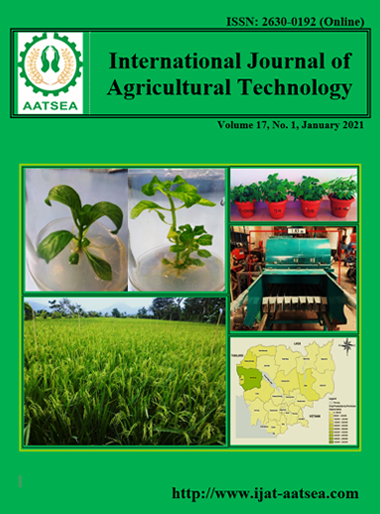Thai traditional bent tree development by mother of Cocoa (Gliricidia sepium)
Main Article Content
Abstract
There were four marking criteria and five major indicators of Thai bent trees. The indicators involved in the balance, rhythm, completeness and beauty and criteria consisted of number of bouquets, number of levels, the horizontal plane in each level, the rhythmic positioning of the bouquet in each level and the meaning or uniqueness. Moreover, the growth rate was measured from the development of the trunk’s diameter, mother of cocoa after bent in nine different patterns. “Mai Khabuan” showed the highest growth rate compared to others; both growth rate of stem and main branch with 6.23% and 85.53% compared to week 0. However, the most beautiful and suitable forms of Thai traditional bent tree by mother of cocoa were “Mai Hok-Hiean”, “Mai Khen” and “Mai Chark” respectively
Article Details

This work is licensed under a Creative Commons Attribution-NonCommercial-NoDerivatives 4.0 International License.
References
Anothai (2006). Professional on Thai Bent Tree. Bangkok: Sukapabjai Publishing.
Cushman, J. and Bohnert, H. J. (2000). Genomic approaches to plant stress tolerance. Current Opinion in Plant Biology, 3:117-124.
Farooq, M., Wahid, A., Kobayashi, N., Fujita, D. and Basra S. M. A. (2009). Plant drought stress: effects, mechanisms and management. Agronomy for Sustainable Development, 29:185-212.
H. R. H. Prince Damtong Rajanupab (1929). The phloem of Thai Bent Tree by Loung Mongkolrat (Chong Krairuek) Bangkok: Sophonpipatgthanakorn Publishing.
Ibbotson, A. and Kennedy, J. S. (1950). The distribution of aphid infestation in relation to leaf age. Annals of Applied Biology, 37:680-696.
Institution of Extension and Development on Knowledge Innovation (2006). Siamese Rough Bush: Thai Bent Trees. Office of the Non-Formal and Informal Education. Bangkok: Office of the Non-Formal and Informal Education.
Munns, R. (2002). Comparative physiology of salt and water stress. Plant, Cell & Environment, 252:239-250.
Office of Royal Society (2009). Thaksinivatara. (Online). Availavle: http://www.royin.go.th/ (April, 8, 2019).
Powell, G. and Hardie, J. (2000). Host-selection behaviour by genetically identical aphids with different plant preferences. Physiological Entomology, 25:54-62.
Rosenzweig, C. and Parry, M. L. (1993). Potential Impact of climate change on world food supply: A summary of a recent international study. In: Agricultural Dimensions of Global Climate Change. Florida: St. Lucie Press.
Somboonna, O. (2009). “Bai Sri”. The Treasury Department. (Online). Availavle: http://emuseum.treasury.go.th/article/606-baisri.html, May, 12, 2019.
Yamamoto, H., Yoshida, M. and Okuyama, T. (2002). Growth stress controls negative gravitropism in woody plant stems. Planta, 216:280-292.


